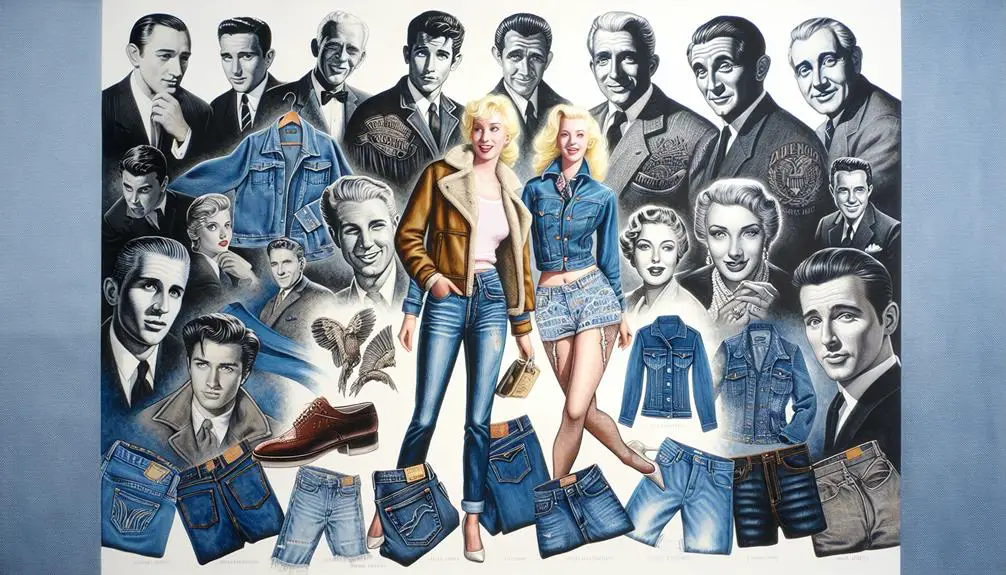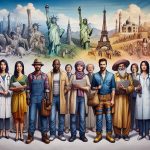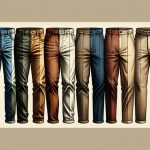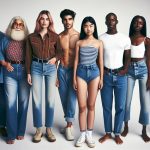I've always been fascinated by how denim went from being utilitarian workwear to a global fashion icon, and it's hard to ignore the roles Marlon Brando and James Dean played in this transformation. Their appearances in 'The Wild One' and 'Rebel Without a Cause' didn't just showcase their acting chops; they turned denim into a symbol of youthful rebellion and cool. But there's more to the story than just a couple of Hollywood icons throwing on jeans. The journey of denim through the decades, evolving with cultural shifts and fashion trends, is a testament to its versatility and enduring appeal. And if you're curious about how denim conquered the world, stick around; there's plenty of intrigue in the weave of this fabric's history.
Table of Contents
Key Takeaways
- Levi Strauss and Jacob Davis patented riveted work pants in 1873, marking the beginning of denim's popularity.
- Marlon Brando and James Dean popularized denim as a symbol of youth and rebellion in the 1950s.
- Designer brands like Calvin Klein and Gloria Vanderbilt introduced high-end denim in the 1980s, further elevating its status.
- The versatility and durability of denim were embraced globally, thanks to its association with American culture and rock 'n' roll.
- Denim transitioned from workwear to fashion staple, symbolizing freedom and creative expression in modern times.
Origins of Jeans
Levi Strauss and Jacob Davis kicked off the denim craze in 1873 by patenting riveted work pants, transforming them from tough workwear to a fashion icon. Before this genius move, denim was just sturdy material meant for those who needed durability in their daily grind. But let's not get it twisted; this wasn't an overnight sensation. It took some serious innovation and a bit of fashion forward thinking.
Here's the lowdown: Jacob Davis had this bright idea to strengthen the pants with rivets at points of strain. Picture this, you're a worker, constantly bending, lifting, and moving. Your pants are the first to give up. Enter rivets, and boom, your pants last longer. Davis, however, needed a business partner to get this idea off the ground. Enter Levi Strauss. Together, they used a twill weave cotton fabric dyed with indigo to create what we now know as blue jeans.
These weren't just any pants; they were a statement. Durable, practical, and thanks to the indigo dye, they didn't show dirt easily. It's incredible to think that this humble beginning laid the groundwork for denim becoming the ultimate wardrobe staple.
Levi Strauss & Co
I've got to say, when talking about who really kicked denim into high gear, you can't skip over Levi Strauss & Co. They're the brains behind the game-changing idea of riveted jeans back in 1873.
This move didn't just make pants tougher for miners; it set the stage for denim to become a global fashion icon.
Founding of Levi Strauss
In 1853, a Bavarian immigrant named Levi Strauss kicked off what would become the iconic denim empire, Levi Strauss & Co, in San Francisco. He wasn't messing around. Fast forward a bit, and he's teaming up with tailor Jacob Davis. What for? To patent these crazy durable riveted denim workwear pants in 1873.
This duo didn't just create pants; they sparked a revolution in workwear. Imagine miners and laborers back then, finally getting their hands on denim that wouldn't just tear on them. We're talking high-quality, durable gear that could take a beating. That's the legacy of Levi Strauss and Jacob Davis – turning denim into the go-to fabric for folks who needed their clothes to last.
Evolution of Denim Jeans
After setting the stage with their durable, riveted work pants, let's see how denim jeans evolved into a fashion staple with Levi Strauss & Co. leading the charge.
These guys, Levi Strauss and Jacob Davis, basically hit the jackpot in 1873 by patenting denim jeans with that clever riveted design. Originally, denim was all about being tough enough for miners and laborers.
But here's where it gets cool: Levi Strauss & Co didn't stop at just making workwear. They pushed denim into the limelight, turning it from simple durable pants into a must-have in everyone's wardrobe.
This evolution from sturdy workwear to mainstream fashion wasn't just by chance. It was their innovative approach that made denim jeans a staple in fashion history.
Global Denim Influence
Levi Strauss & Co didn't just revolutionize workwear; they catapulted denim onto the global stage, making it a symbol of style and rebellion. When they teamed up with Jacob Davis, these guys weren't messing around. They saw a need for durable denim garments that could withstand the rigors of hard labor. But what they didn't anticipate was how their riveted jeans would transcend workwear, embedding themselves into the very fabric of American culture and beyond.
It's fascinating how their creation morphed from practical attire into a fashion statement, embodying youth and rebellion. Levi Strauss & Co's innovative spirit didn't just change how we see denim; it redefined fashion itself. They've shown the world that denim isn't just about durability; it's a canvas for expression, a staple of fashion, and a timeless symbol of rebellion.
Denim in Fashion
Now, let's chat about how denim found its way into the fashion world.
It's fascinating to see how this fabric shifted from practical workwear to a staple in everyone's closet, signaling a major shift in cultural attitudes and style trends.
From its origins to its impact on culture and the latest trends, denim's journey is truly remarkable.
Origins of Denim
Denim's journey from practical workwear to a bold fashion statement kicked off when icons like Marlon Brando and James Dean rocked them in the 1950s. Hollywood's embrace by these legends wasn't just about looking cool; it was a shout of rebellion that resonated with the youth culture of the time.
- *Marlon Brando astride his motorcycle, jeans hugging his legs*
- *James Dean's smoldering gaze, denim perfectly rumpled*
- *Levi Strauss and H.D. Lee tags peeking from under leather jackets*
- *A sea of young fans, denim-clad, echoing their idols' defiance*
- *The sound of rock 'n' roll, the unofficial anthem of denim wearers*
These moments weren't just fleeting trends. They etched denim's place in fashion, turning it from mere workwear into a symbol of youth, rebellion, and style mastery.
Denim's Cultural Impact
Through the decades, denim's transformation from rugged workwear to a fashion icon tells a story of rebellion and style that's hard to ignore. Icons like Elvis Presley and James Dean draped in denim became the epitome of cool, embedding it deeply into rebellious youth culture.
It wasn't just their doing, though. Big names like Levi Strauss and H.D. Lee saw the trend and ran with it, tailoring their denim to fit the ever-evolving fashion trends. This fabric's journey reflects its significant impact on American culture, influencing everything from everyday attire to high-end fashion.
Denim's history, interwoven with fashion trends and cultural shifts, showcases its undeniable mark on contemporary fashion trends. It's more than just clothing; it's a cultural statement.
Modern Denim Trends
I've noticed how today's fashion scene's obsession with denim reflects its versatility and enduring appeal. Icons like James Dean and Elvis Presley kicked it off, turning denim into a canvas of rebellion and youth culture. Now, we're seeing that legacy evolve with every trend:
- Designer denim taking cues from the '80s, blending luxury with casual.
- Hip hop influences, showcasing baggy styles and bold logos.
- Customization trends, where personal flare meets mainstream fashion.
- DIY projects, embodying the spirit of individuality and creative expression.
- Rebellious threads, echoing the past while crafting the future of fashion.
This mix captures today's denim landscape, from high-end runways to streetwear, proving denim's timeless role in expressing identity and breaking norms.
Rise to Fame in the 1950s
In the 1950s, Hollywood legends like Marlon Brando and James Dean turned denim into the ultimate symbol of youth rebellion by rocking it in their blockbuster hits. Suddenly, denim wasn't just workwear; it was a statement of freedom and individuality. Watching Brando in his leather jacket and denim jeans, or Dean in 'Rebel Without a Cause,' you couldn't help but feel the raw energy and defiance they exuded. It was electrifying.
These iconic figures made denim more than just clothing. They infused it with a spirit of rebellion, making it a fashion staple for anyone looking to push against the norms. Their influence was massive. You saw it everywhere – from high school hallways to the coolest parties in town. Denim became the uniform of the young and restless, a badge of coolness and non-conformity.
What's fascinating is how these Hollywood stars managed to elevate a simple fabric to legendary status. Denim wasn't just denim anymore; it was a symbol of a generation clamoring for change, for the freedom to be themselves. And that's the magic of fashion – how a single trend, backed by the right icons, can capture the mood of an era.
Designer Denim Evolution
After exploring how denim symbolized rebellion in the 1950s, let's look at how the 1980s brought us the rise of designer denim. This era marked a significant shift in the denim evolution, transforming it from a symbol of counterculture to a staple of luxury fashion. Brands like Calvin Klein and Gloria Vanderbilt were at the forefront, introducing high-end denim that everyone just had to have.
But the evolution didn't stop there. The '90s saw hip hop culture put its own spin on designer denim, with brands like Tommy Hilfiger and Guess becoming iconic. Fast forward to the 2000s, and we're all about DIY customization—think distressed, embellished jeans that let's express our individual style.
- Calvin Klein and Gloria Vanderbilt: Introduced high-end denim in the 1980s.
- Hip Hop Influence: Tommy Hilfiger and Guess in the '90s.
- DIY Customization: 2000s trend of distressed and embellished jeans.
- Sustainable Practices: Eco-friendly denim by Stella McCartney.
- Ethical Production: Reformation's commitment.
Designer denim continues to innovate, now with a strong focus on sustainable practices and ethical production. Brands like Stella McCartney and Reformation are leading the way with eco-friendly denim, showing that fashion can be both stylish and kind to our planet.
Denim's Global Influence
Denim's journey from rugged workwear to global fashion icon shows how it's won hearts everywhere. Hollywood icons like Marlon Brando and James Dean weren't just actors; they were the torchbearers that brought denim into the limelight. Their roles in movies, especially James Dean in 'Rebel Without a Cause,' showcased denim as the ultimate symbol of youth and rebellion. This wasn't just about clothing; it was about making a statement. The rock 'n' roll culture of the era embraced denim, furthering its association with freedom and rebellion.
Here's a quick snapshot to show denim's incredible journey:
| Era | Icons | Impact |
|---|---|---|
| 1950s | Marlon Brando, James Dean | Introduced denim as leisurewear, symbol of rebellion |
| Rock 'n' Roll Era | – | Cemented denim's association with youth culture |
| Global Spread | – | Versatility and durability made it popular worldwide |
| Present Day | – | Remains a staple in fashion, symbolizing freedom and comfort |
Denim's versatility has allowed it to evolve beyond workwear to an essential part of our daily lives. It's amazing to see how it's become a universal language of comfort, style, and rebellion.
Frequently Asked Questions
Who Popularised Denim?
I've learned that Marlon Brando and James Dean really kick-started denim's popularity in the '50s. Their movie roles made it a youth symbol. Musicians like Elvis kept that trend going, making denim a fashion staple.
Who Started the Denim Trend?
I've been digging into fashion history, and it turns out Levi Strauss and Jacob Davis kick-started the denim trend in 1873. Their invention of riveted jeans turned denim into a global wardrobe staple.
When Was Denim Popularised?
Denim was popularized in the 1950s, becoming a mainstream fashion staple thanks to Hollywood and the music industry. It marked a shift from workwear to a symbol of rebellion and youth culture for generations.
Who Popularized Blue Jeans?
I've learned that Levi Strauss and Jacob Davis were behind making blue jeans famous by patenting them in 1873. Later, Hollywood icons and the music scene turned them into a symbol of cool rebellion.
- How Does Ring Spun Cotton Affect Garment Fit and Shape Retention? - August 13, 2024
- What Are the Challenges in Producing Ring Spun Cotton? - August 13, 2024
- Is Ring Spun Cotton Suitable for Plus-Size Clothing? - August 13, 2024







